 A tide pool. Madi McKay photo
A tide pool. Madi McKay photoPitch black, it was the middle of winter, late in the evening. The wind was howling — cold creeping through the cracks of my bundled layers. “Today we will find an octopus, I can feel it,” Madi told me as we descended down salt-seasoned concrete steps to the rocky reef below. I chuckled, she said that every time.
At the bottom of the steps, the search was on. We started scanning nooks and crannies for creatures — creatures so bizarre, they seem straight out of the imagination.
Intertidal animals come in a wide variety of colors, shapes and sizes. Nowhere else have I seen a more diverse array of animals. In a one-meter area of a tide pool, you could see anemones, crabs, fish, shrimp, sea stars, sea cucumbers, urchins, sea slugs and octopus (if lucky). The list goes on.
These animals live underwater, subject to currents and waves much of the time, but are exposed at low tide. Madi knew some of the lowest tides during winter are at night and somehow convinced me to brave the elements.
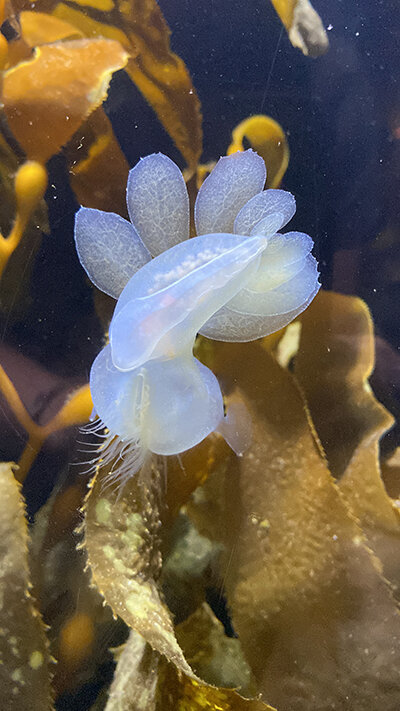 Hooded Nudibranch. Madi McKay photo
Hooded Nudibranch. Madi McKay photoMadi became obsessed with tidepooling a few years into college. She was studying biology at Western Washington University and took any opportunity to get into the field. Eventually, she started dragging me along to beaches around Bellingham — Larrabee State Park, Clayton Beach and Teddy Bear Cove.
In Bellingham, we’d often find the hooded nudibranch, a type of sea slug. The largest of these nearly transparent creatures fits snugly into the palm of your hand. Found in the shallow waters around Larrabee during the summer months, they undulate their bodies aimlessly, almost in dance. Madi discovered that they gather by the thousands on eelgrass beds in late summer to mate. Fun fact: They smell like watermelon Jolly Ranchers.
Slowly, Madi’s ambition took her farther and farther from home. We began to explore the jetties of Westport, docks of Tacoma and rocky reefs on Juan de Fuca Strait. Luckily for her, I was always ready for it, as long as I could bring my surfboards.
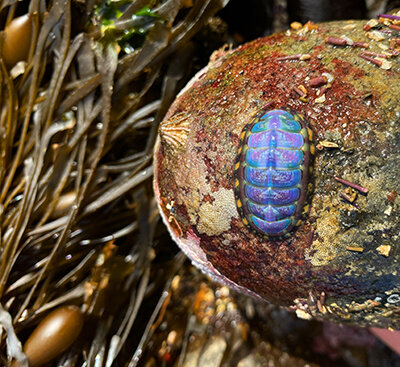 Chiton. Madi McKay photo
Chiton. Madi McKay photoOf all the places we frequented, there was one we both fell in love with, Tongue Point on Juan de Fuca Strait. It was here that Madi and I found ourselves that night, bundled head to toe on a cold November evening.
Tongue Point is a rocky reef point in the Salt Creek Recreation Area. Snow capped peaks of Vancouver Island cover the northern horizon, a sandy crescent-shaped beach, aptly named Crescent Bay, lies just to the west. A summer sunset here is a rosy kiss of cosmic divine. As the sun drops into the mouth of the strait, the sea mist bends the rays to off shades of purple and red — the farthest reaches of light spread west to Mt. Baker, illuminating its peak for minutes after sunset.
Looking over the point at high tide, it’d be hard to tell there is anything of interest beneath the chaos of the crashing waves. But that couldn’t be further from the truth. As the tide retreats, a few exposed rocks turn into a massive field of open barnacle and kelp-covered rock, and to Madi, a gold mine of discovery.
 Urchin. Madi McKay photo
Urchin. Madi McKay photoTongue Point is nearly 300 yards long and has over 2.5 acres of exposed intertidal habitat at low tides. Our game plan was to walk straight out to the end of the point to an area that was only exposed at the lowest tides. These areas are only available to tidepoolers a few times a month at most, so there’s a much better chance to find animals that have been caught off guard by the low tide and didn’t have time to retreat to deeper water. When the rare sightings of the giant Pacific octopus do occur, they are typically in this area.
 Madi McKay properly bundled. Ian Ferguson photo
Madi McKay properly bundled. Ian Ferguson photoWe started marching, stumbling over loose rocks and treading lightly to avoid exposed barnacles and kelp. When we reached the end we shined our flashlights to illuminate the water's edge. There were waves crashing, the wind blowing off their tops, sending plumes of water high into the air. We exchanged shouts through the piercing wind and turned our attention to the ground.
The floor was a collage of greens, purples, reds and oranges. A layer of kelp rested limply on nearly every rocky surface. In the pools, dozens of urchins crowded together. Through their vibrant violet hues, touches of red refracted through the water.
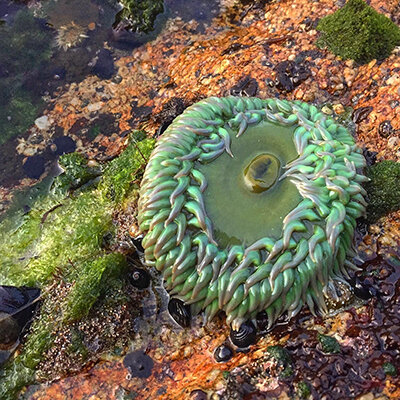 Sea anemone. Madi McKay photo
Sea anemone. Madi McKay photoFrom a standing position, the urchins morphed together in one mass of color. Though when I got close, I saw these were in fact living, breathing animals. I watched hundreds of tiny tube feet project out of their spines. We found some that had collected shell fragments and crab molts to wear as armor.
To me, this is the magic of tidepooling. Life at every level is nearly fractal. From a distance, you may spot kelp, groups of urchin, clusters of sea anemone and the occasional ochre star. But the closer you look, the more life you’ll find. Look under the kelp you might find crabs, baby ochre stars, tiny bright-red blood stars, and glowing, seemingly-fluorescent sea slugs. With a closer inspection of the baby ochre star, you might find that it’s resting on a bed of sponge, and that sponge is living and growing on the shell of a crab. (Yes, this is something Madi has found, Spongebob, Patrick and Mister Crabs all hanging out together!)
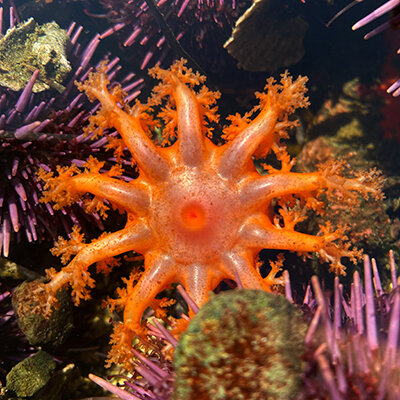 Sea cucumber. Madi McKay photo
Sea cucumber. Madi McKay photoMadi has this innate ability to catapult herself into the space where these animals spend their lives, and it never ceases to amaze me. Within minutes she starts pointing out incredible finds. She showed me an opalescent nudibranch. This one was no larger than a silver dollar, and on its back were dozens of finger-like structures called cerata. The cerata were off-white at the base and blended to a fiery orange tip. The collection of cerata floated and waved in the currents of the pool, and gave the impression of being soft, almost furry.
The opalescent nudibranch primarily feeds on anemones. The anemones have stinging cells, but they don’t harm the nudibranch, rather the nudibranch reuses these stinging cells in the tips of their cerata as a defense against predators. Some scientists believe their bright colors are a warning to predators — “If you bite me, it’ll sting!”
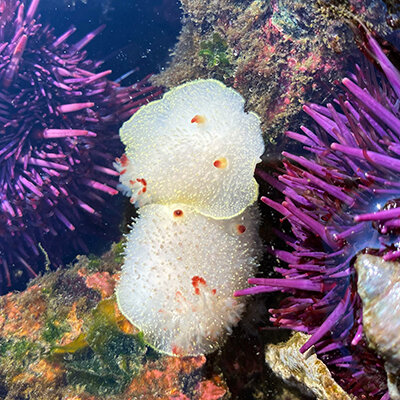 Sea slug. Madi McKay photo
Sea slug. Madi McKay photoI asked Madi how in the world she finds these tiny little animals. She casually said she just looks for the colors. Seemed easy enough.
I continued to poke around, keeping an eye out for the colors. An hour had passed and the tide started to move back in. Madi started to get discouraged, she claimed again that she really thought today was the day we’d find an octopus. She always got her hopes up. But really, what are the chances that we find one of the most elusive animals in the intertidal zone?
I didn’t admit it, but I felt something too. Tonight did feel like the night we’d find one. Maybe we just felt entitled to it, because of the sacrifice and work we put in to be here. Not just braving the elements in the tide pools, which was novel enough to still be fun. But later we’d struggle to find warmth sleeping on the windswept bluff, with temperatures dropping to the 30-degrees. And we drove hours earlier that morning to get here, and tomorrow we’d drive hours back home.
We slowly started making our way back to the bluff, just barely outpacing the tide. Madi stopped every few yards to examine new pools without much luck. I was tired, and the cold was getting to me. I started pleading with Madi that we head back and get warm. She agreed, just after one more look.
As I watched Madi, keeled over, perusing through thickets of kelp, grumpy and cold, I saw something in the corner of my eye — a flash of orange. Look for the colors.
 Great Pacific octopus. Madi McKay photo
Great Pacific octopus. Madi McKay photoMy heart lurched into my throat before I knew what I saw. I aimed my flashlight into the large tide pool to my right. Right there, contrasted with a purple backdrop of urchins, was a bright orange giant Pacific octopus.
I could barely get the words out of my mouth, “Madi! Octopus!” She leaped up, and for a few brief moments, we watched in awe as the animal slinked around the tide pool floor, before quickly finding shelter under an overhang of rock.
The moment was so brief, so fleeting. Miraculously, Madi’s adrenalin-fueled thumb had found its way to the record button on her phone, and we got to capture these few moments with this remarkable animal.
In an instant, all our longing for the warmth of fire disappeared. We got low and quiet and huddled around the small cave in the tide pool to see if the creature would gift us another encounter. We waited, and waited but it never came back out. We said our goodbyes and gave our gratitude to our little friend, who we could not see, but whose presence could be felt.
Back at the campsite, we studied the video, observing its orange textured skin and how it slinked around using its arms to walk. Its cadence was slow and methodical.
We could only guess what the animal was doing outside its den. Once we spotted it, it stayed in our presence for no more than 20 seconds. Was it searching for a way out of the pool? Was it hunting? Was it saying hello? The latter is what I like to think. x
On weekends Ian Ferguson is either chasing waves, freediving or doing his best ‘snowboarder’ impression. During the week he daydreams at his day job about buying a van to drive to Mexico ... He doesn’t care how clichéd it sounds.